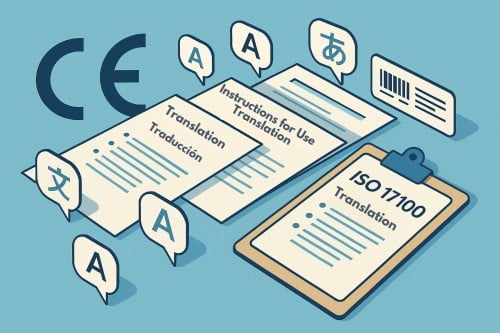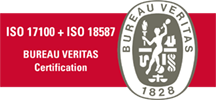CE Marking Documentation: How to Translate Declarations, IFUs & Labels
Translation for CE marking documentation demands accuracy, traceability and layout parity. We explain workflow, QA and DTP so Compliance, Engineering and Ops can ship.

Table of Contents
What “translation for CE marking documentation” must include
For EU market access, product information must be correct in the official languages of the target countries. That is why translation for CE marking documentation covers user-facing and regulatory files: Declarations of Conformity, Instructions for Use, safety labels, packaging and service manuals. The European Commission’s overview explains when CE rules apply and how the mark relates to product categories, notified bodies and manufacturer obligations; use it as a framing reference, then adapt it to your technical file structure. In practice, translation for CE marking documentation becomes a repeatable workflow aligned to your release cycle, with versioning and audit evidence.
Decision-makers often ask whether a generalist vendor suffices. The safer route is a technical stack with translators experienced in directives and harmonised standards, plus an editor and proofreader under a traceable process. When content touches legal statements, declarations or warranty terms, pair your core team with legal translation services. When content is engineering-heavy (IFUs, maintenance procedures, risk controls), route it through technical translation and retain diagrams, callouts and cross-references.
Why regulated teams require “translation for CE marking documentation”
The Blue Guide clarifies roles across manufacturers, importers and distributors, and how documentation supports conformity assessment and surveillance. The implication is simple: translation for CE marking documentation is not a stylistic pass—it is part of compliance evidence. A robust workflow combines bilingual TEP (translate–edit–proof), terminology governance, controlled anchors to standards and a documented sign-off. When authorities or partners ask for proof, you can show translator qualifications, revision records and change logs. If you also need sworn deliverables for tenders or court filings, add certified translations and keep certificates with your technical file.
Handover-ready deliverables for Declarations, IFUs and labels
Compliance teams want files they can drop into the technical file and the packaging line. Aim for a pack that includes bilingual PDFs or tracked Word files, a termbase extract, and print-ready artwork. Link these to your master document list and keep language coverage aligned to your market plan. Where medical devices or other high-risk products are involved, ensure IFUs follow MDR and standardised symbols; add references to the underlying standard in your termbase to avoid drift.
Operationally, fold translation into your release gates. For example, gate G3 could require updated DoC, IFU and labels in all target languages, with review tickets closed and DTP QA passed. If you need a cost or timing estimate for the next release, ask our team early via the request a quote form so we can reserve linguists and DTP time.
Governance: terminology, TEP and ISO 17100
Quality hinges on consistent terminology and a clean TEP chain. Translation for CE marking documentation works best when you maintain a living glossary of product names, safety phrases and standards references. Under ISO 17100 certification, every translation is revised by a second linguist; retain the editor’s changes and rationales in your repository. Add a critical or focused review when risk justifies it; we describe these escalation layers on our quality control and rigorous review pages. Translation for CE marking documentation benefits from this governance because it creates traceability you can show in audits and supplier evaluations.
Multilingual DTP and label constraints
Layouts matter. Labels have character limits, mandatory symbols and pictograms, and minimum x-heights. Translation for CE marking documentation should include multilingual DTP that preserves styles, tables and callouts, and aligns line breaks with hazard statements. Build language-aware templates for small packaging and for complex IFUs. Keep vector formats (AI, INDD, SVG) as masters, and generate PDFs with embedded fonts. When symbols or local language names of authorities apply, coordinate with your artwork team early and document the decision in your change log. If your content pipeline includes marketing leaflets or manuals beyond strict compliance scope, connect them to the translation services hub to keep tone and terminology aligned.
Turnarounds, SLAs and change control
Release managers care about predictable lead times. For planned updates, translation for CE marking documentation can run in parallel with verification testing if strings are frozen. For urgent safety notices or field actions, define an SLA with on-call linguists. Use a change log to record what changed, why, and which languages were touched. Keep previous versions in your technical file for traceability. A short “differences” report helps reviewers focus on affected passages. When budgets and dates collide, our team uses priority routing and senior editors to compress cycles without cutting the second-linguist step; see how we handle deadlines on deadlines and quality and the broader culture of continuous improvement.
Comparison tables: scope, deliverables and SLAs
Scope by document type
| Document type | Typical source formats | Review intensity | Notes |
|---|---|---|---|
| Declaration of Conformity | DOCX, XML | Medium (legal check) | Verify product IDs, directives, standards citations. |
| IFU / Manual | Word, InDesign, XML/DITA | High (technical + usability) | Validate steps, warnings, cross-refs and graphics. |
| Safety labels / Packaging | AI/INDD, PDF, SVG | High (space-constrained) | Respect character limits and symbol rules. |
Deliverables & QA
| Pack item | What you receive | Purpose |
|---|---|---|
| TEP bilingual files | Translated + edited + proofed | Audit trail, reviewer clarity. |
| Termbase extract | Key terms + approved equivalents | Prevent drift across releases. |
| Print-ready PDFs | One per language | Handover to packaging line. |
| Artwork sources | AI/INDD/SVG with fonts | Future edits and variant SKUs. |
| Change log | Version deltas per language | Traceability for authorities. |
Turnaround SLAs (indicative)
| Scenario | Volume | Typical lead time |
|---|---|---|
| Planned release (all files) | 20k words + 10 labels | 10–15 working days |
| Minor delta (DoC update) | ≤2k words | 2–3 working days |
| Urgent safety notice | ≤1k words | 24–48 hours (pre-arranged) |
Throughout, translation for CE marking documentation benefits from early scoping and stable strings. Build that habit and you reduce cost and risk while keeping every market supplied.
FAQ
Q1. Which EU rules define the documentation that needs translation?
CE marking spans multiple product groups and their specific legislation. The European Commission’s guidance explains the role of the mark, the conformity assessment routes and how documentation supports market surveillance. In short, where a directive or regulation requires user information to be in the language of the end-user, manufacturers must supply that content accordingly. That usually means Declarations of Conformity, safety information, labels and instructions in the languages of the destination markets. The Blue Guide offers practical detail on responsibilities for manufacturers, authorised representatives and importers, and how documentation underpins compliance across the supply chain. Teams should map their products to the applicable rules, confirm language obligations for each target country and adjust document sets by risk class and channel.
Medical devices and some other categories also impose stricter content and symbol requirements. For those, instructions, warnings and certain labels rely on harmonised standards and standardised icons. You should document which standards you use, keep symbol legends current and ensure that your translation process includes second-linguist review. When in doubt, record the decision in your quality system and reference the underlying standard or guidance page for later audits.
Q2. How do we manage terminology and avoid inconsistencies across releases?
Start with a product-level glossary that covers component names, hazards, safety phrases, interface terms and references to directives or standards. Use it in your CAT/TMS so translators see approved terms and notes as they work. A practical approach is to designate an owner on the product team, collect terminology queries during translation, and resolve them in a weekly cadence. Under an ISO-aligned process, each translation passes through translation, independent edit and proof stages; the editor’s changes feed back into the termbase so the next release starts stronger. When teams skip that loop, inconsistencies creep in and reviewers have to correct the same issues repeatedly. The slight overhead of glossary maintenance pays for itself in shorter review cycles and fewer DTP fixes.
If you handle multiple product lines, separate termbases by family and share a common safety lexicon. This avoids the trap of over-generalising or polluting terms across lines. Keep change logs for the termbase itself, and include version IDs in your document control headers. When you introduce a new market language, schedule a terminology pass first; that reduces rework once the full document set is in flight.
Q3. What does “multilingual DTP” cover for IFUs and labels?
Multilingual DTP ensures the translated text fits the same layout, structure and visual hierarchy as the source. For IFUs, that includes page geometry, tables, cross-references and callouts tied to diagrams. For labels, it means working within strict spatial limits, preserving pictograms, minimum font sizes and colour contrasts. The DTP team should receive source files (AI, INDD, SVG), fonts and linked graphics, plus a short brief on constraints such as panel sizes or regulatory icons. After TEP, the linguist or editor reviews the laid-out files to catch line break issues, truncated warnings or unit formatting errors. That last review is critical on small labels where a single bad break can change meaning.
To speed up cycles, maintain language-specific templates for small packaging and for dense warning panels. Use styles and paragraph rules rather than manual spacing so layout changes propagate safely. Keep a “shrink-to-fit” policy off by default; instead, adjust micro-copy with your linguist to preserve clarity within the available space.
Q4. How fast can translation for CE marking documentation be turned around?
Lead time depends on volume, languages and whether artwork is stable. For planned releases, we can run translation alongside late-stage verification once strings are frozen, and deliver in batches so your reviewers start early. For minor DoC changes or a small set of labels, short cycles are common, especially if terminology is settled and templates are in place. Urgent safety notices need pre-agreed SLAs, with on-call linguists and DTP capacity. Even then, we keep the second-linguist step intact; cutting review seems fast, but it increases risk and drags teams into rework after print.
The best way to protect dates is to treat translation as a standard gate in your release plan. Provide clean sources, state target countries and languages, and note any risk-relevant passages that require senior review. When you can, share upcoming changes ahead of time so we can preload termbases and reserve specialists. That preparation often saves days when you reach code freeze and need to hand off to packaging.
Links
- Internal:
- External:

